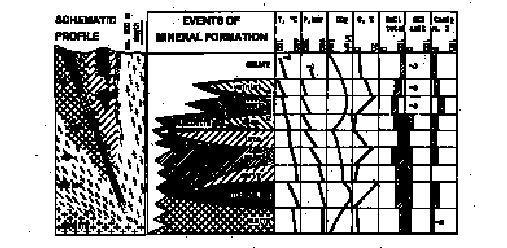
The origin of the metasomatic rocks in the complex gneissic-schistose series of Izera area (see Figure) is usually bound to the neighbouring and underlying Karkonosze (Riesengebirge) granitoid of Variscan age (Karwowski, 1977; Kozlowski, 1978). The metasomatites comprise albitites and greisens; both of them form zones of W-E extension along the chlorite-mica schist belts, that intercalate the gneisses. Within the greisen zone, however, the greisen varieties (quartz-tourmaline, quartz-topaz, quartz-mica, all of various mineral proportions, and almost pure-quartz greisen, plus fluorite as disseminated grains, several-centimeters nests and pockets, and thin veinlets) have patchy distribution. Metasomatizing solutions were investigated by means of fluid inclusion methods in the minerals of the albitite, greisens and veins. Their characteristics for the sequence of the metasomatic and vein minerals is given in the Figure; note, that the temperatures are pressure-corrected fluid inclusion homogenization temperatures. The parent fluids of the metasomatites were mainly liquid,
i.e. hydrothermal; pneumatolytic inclusions were found only exceptionally. Temperature of the metasomatic process decreased gradually; pressure (determined from CO2-bearing inclusions) changed from ca. 0.9 kbar to ca. 0.5 kbar at the end of the process. The lower pressure values during the fluorite formation could be connected with opening of small fissures and voids. Carbon dioxide content and salinity varied strongly, what probably was caused by inflow of
separate portions of solutions to different parts of the metasomatized rock. The granitoid massif could supply Na for oligoclase-by-albite replacement in the gneissic rocks to form albitite. The resulting release of Ca is confirmed by margarite crystallization in the schists (Makala, 1994). The decomposing gneissic biotite supplied Fe, Mg, F and at least part of B (present as trace element) to the formation of tourmaline and topaz (consuming fluorine). Destroyed gneissic micas and microcline yielded potassium used afterwards in topaz muscovitization and formation of primary muscovite in greisen. Fluorine, released from muscovitized topaz, precipitated with calcium as fluorite. Supposedly, the Karkonosze intrusion generated chemical fronts in its cover rather, than it was the source of all the elements causing metasomatic alterations. Note: this study was in part supported by the grant KBN 606/P04/95/08, Poland.
Karwowski, L., Arch. Mineralog. 33, 83-148 (1977).
Kozlowski, A., Acta Geolog. Polon. 28, 171-222 (1978).
Makala, A., Arch. Mineralog. 50, 31-54 (1994).
Fig. 1.